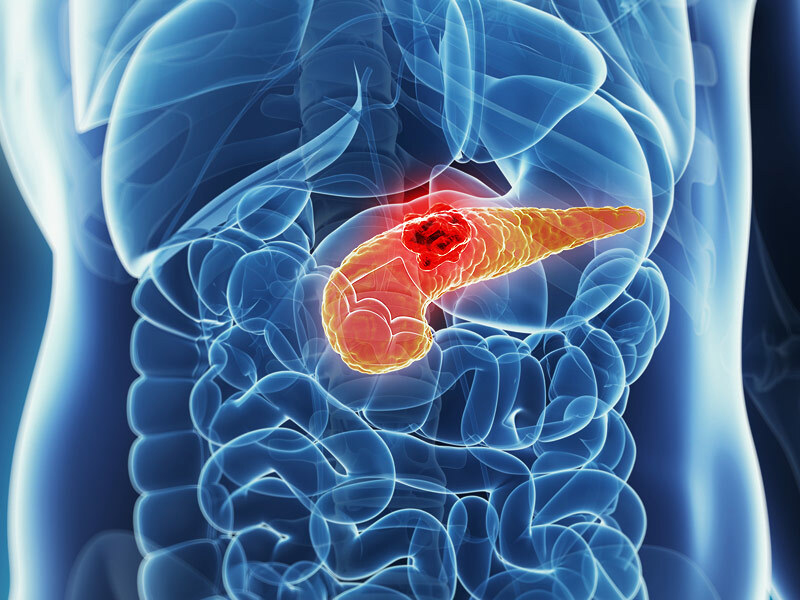Acute and Chronic Inflammation of the Pancreas (Pancreatitis)
Acute inflammation of the pancreas occurs when pancreatic enzymes are activated in the pancreatic tissue and digest the pancreatic tissue, triggering an inflammatory reaction. In 80-90% of patients, this inflammation is limited to the pancreas and usually heals quickly with medical treatment (mild pancreatitis). However, in some patients, a severe inflammatory condition can occur in the pancreas and its surroundings, even in distant organs (severe pancreatitis). Severe pancreatitis can be life-threatening.
There are numerous factors that might lead to acute pancreatitis, but gallstones and alcohol use are the two main contributors. Nearly all patients report having excruciating stomach pain. Nausea and vomiting are also common symptoms . Blood tests and imaging techniques like computed tomography and ultrasonography are frequently used in diagnosis. Surgery or other invasive interventions should be avoided in acute pancreatitis unless there is an infection or abscess with necrosis (cell death) of the pancreatic tissue. Acute inflammation due to gallstones requires the removal of the gallbladder. However, removal of the gallbladder is usually delayed until about 6 weeks after pancreatitis has been treated with medication. The aim is to give time for the resolution of the inflammation due to pancreatitis.
Chronic pancreatitis is characterized by persistent inflammation and permanent loss of normal pancreatic tissue. The patient may experience chronic abdominal pain, digestive problems due to insufficient digestive enzymes, and endocrine problems (diabetes) due to lack of hormones (insulin) secreted from the pancreas.
Treatment of chronic pancreatitis is generally aimed at treating the patient's pain, poor digestion, and, if present, diabetes. Generally, surgery is not required. If the cause of the pain is the presence of stones or stenosis in the pancreatic duct, these conditions can be eliminated by endoscopic methods (ERCP). Endoscopic methods can also be used in bile duct obstructions. Surgery is typically necessary in cases of chronic pancreatitis when the patient experiences severe pain that does not subside with medication or endoscopic treatments, intestinal obstruction, or cancer suspicion. The decision of surgery is based on factors such as the patient's complaints and the width of the pancreatic duct.
Cystic Neoplasms (Cystic Tumors) of the Pancreas
Thanks to advances in imaging techniques, cystic tumors of the pancreas can be detected more frequently. There are different types, and these different types have different behaviors. The important thing is to perform differential diagnosis among these types. While follow-up is sufficient for some cystic tumors, others need surgery due to the possibility of cancer. Computed tomography (CT), magnetic resonance imaging (MRI), and endoscopic ultrasound (EUS) are used for diagnosis. Accurate diagnosis and treatment require an experienced team of surgeons, gastroenterologists, radiologists, and pathologists.
Pancreatic Cancer
Pancreatic cancer has a worse prognosis and is more difficult to treat than other tumors. Smoking is the most important risk factor in the development of pancreatic cancer. Smoking is thought to increase the risk of pancreatic cancer threefold. Some other known risk factors are chronic pancreatitis, diabetes, and obesity. There are also hereditary risk factors due to certain gene mutations.
Jaundice may be observed in tumors at the head of the pancreas due to bile duct compression. In such situation, jaundice may be the only symptom or may be accompanied by pain and weight loss. Tumors located in the body and tail of the pancreas may cause abdominal pain in the back and weight loss. Tumors in this region may be silent until the tumor grows and progresses into the surrounding tissues, which may cause delays in diagnosis.
CEA and CA 19.9 levels in blood tests are important in diagnostic studies. Computed tomography is the most important method in diagnosis and staging. In addition, endoscopic ultrasound, MRI, FDG-PET, ERCP, and MRCP can also be used when necessary.
The treatment of pancreatic cancer is surgery. During surgery, regional lymph nodes must also be removed (lymph node dissection). For body and tail tumors, a surgery called distal pancreatectomy is performed. In this surgery, the body and tail of the pancreas from the neck are removed together with the surrounding lymph nodes and spleen. For tumors located at the head of the pancreas, an operation called pancreaticoduodenectomy or Whipple Operation is performed. Regional lymph nodes should also be removed during this surgery. It is located just in front of the inferior vena cava. There are also main vessels of the intra-abdominal organs around the pancreas. Whether or not these vessels are involved can change the treatment plan. In such patients, chemotherapy is administered prior to surgery. After chemotherapy, surgical reevaluation can be done for curative intended resection.
What is Pancreaticoduodenectomy (Whipple Surgery)?
Whipple Procedure is one of the most difficult and risky operations in surgical practice. It is a surgical method applied in tumors of the pancreatic head and other periampullary tumors (duodenum, papilla, distal bile duct tumors). Along with the head of the pancreas, the duodenum (duodenum, common bile duct, gallbladder, the lower part of the stomach (in some cases it can be preserved), and a short segment of the small intestine are removed as a block. The regional lymph nodes around the main vessels must also be removed (lymph node dissection, lymphadenectomy). In cases where some of the main vessels around the pancreas are involved by the tumor, it is possible to remove and reconnect these main vessels. In some cases, synthetic vascular grafts can be placed. After the resection (removal of tumorous organs), the small intestine is connected to the pancreas, bile duct, and stomach (anastomosis).
Due to the presence of large vessels in this region and performance of at least three connections (anastomosis), Whipple Procedure is a challenging and risky operation. Various problems may occur during and after the operation. To minimize these problems, surgical skill and experience should be at a high level and postoperative care should be performed very carefully and meticulously. Surgical skill and experience are critical, especially in cases where unexpected additional problems arise during surgery or additional procedures such as vascular resection are required. It is acknowledged that one of the most crucial elements for both immediate outcomes and long-term survival is a surgical team with experience.
Endocrine (Hormone Secreting) Tumors of the Pancreas
In addition to being a gland that secretes digestive enzymes, the pancreas is also an endocrine organ that secretes various hormones. The most well-known of these hormones is insulin. These tumors are less common and have a better prognosis than cancers. The most common type is an insulin-secreting tumor called insulinoma. The second most common type is a gastrin-secreting tumor called gastrinoma (which increases stomach acid and causes ulcers). Symptoms, clinical behavior, and surgical treatment of these tumors differ. Treatment is decided according to the type of tumor.



